
 Jefferson County, Mississippi
Jefferson County, MississippiA Proud Part of the Mississippi GenWeb!
Contact Us:
State Coordinator: Jeff Kemp
County Coordinator: Gerry Westmoreland

If you have information to share, send it to Jefferson County MSGenWeb.
In the menu on the left there is an index of Military Records on our website.
Before the American Civil War 1861-1865 the only legal tender was
specie, gold and silver coins from the United States Mint. When the
Southern states seceded these coins, and even copper pennies,
disappeared from circulation into private hordes as a hedge against
the uncertainties of wartime. The Confederate government issued no
coinage and generally declined to print notes smaller than five
dollars, so the state and local authorities filled this vacuum with
fractional currency.
These bills were only redeemable at the
County Treasurer’s office in Fayette and were worthless outside the
immediate area. Currency traders offered pennies on the dollar to
exchange notes on distant places of uncertain financial status, and
often banks would not accept them at all. The local citizens took
them as money because there was nothing better.
The first series of Fayette bills were issued Thursday, April 24,
1862, shortly after the disaster of Shiloh (April 6 and 7) and while
a siege of New Orleans was daily expected (the city fell
unexpectedly April 25.)
Typeset locally in Fayette or Rodney
on tissue-thin light blue paper, with handwritten dates, these notes
testify to haste and poverty. The bills state “The County of
Jefferson will pay to Bearer, in Current Funds [whatever those might
be] at the Treasurer's office, the sum of” the face amount.
Similar typeset bills for 25¢, $1, $3 were also issued.
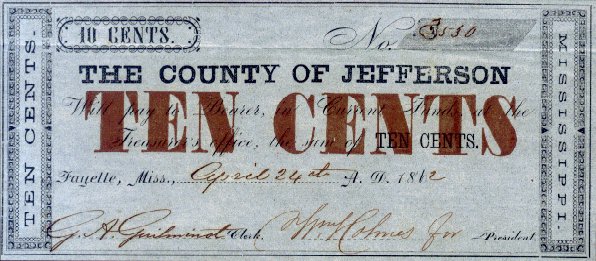
10¢ typeset, brown overprint (catalog Leggett #1)
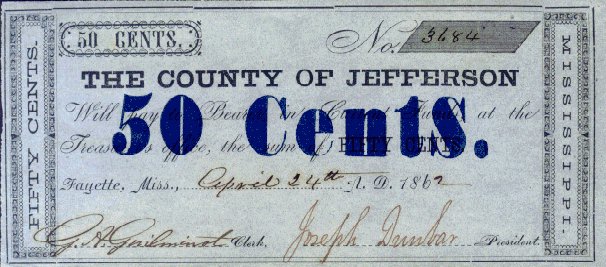
50¢ typeset, blue overprint (#5)
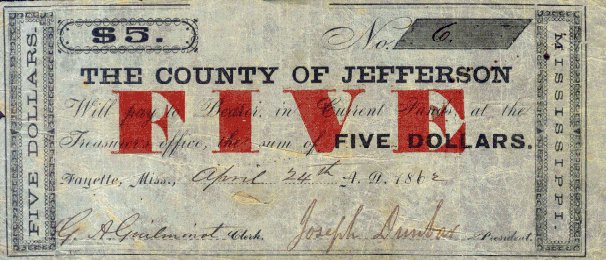
$5 typeset, red overprint, serial number 6 (#10)
The above notes were signed by G. A. Guilminot, County Clerk, and Joseph Dunbar, President of the County Commission.
The second series was issued almost a year The later, Monday, February 23, 1863. By this time the county had adjusted to the loss of markets in Memphis and New Orleans, and the authorities could plan ahead and order from printer W. R. Robertson in Mobile. The county's finances had improved, and these notes declare “The County of Jefferson promises to pay to Bearer in Confederate funds at the Treasurer's office, the sum of” the face amount.
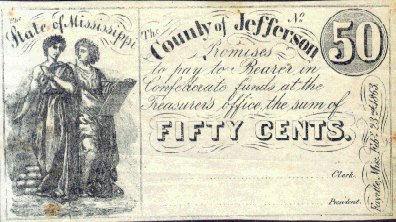
50¢ two schoolboys (#6)
This specimen was never
issued and therefore not signed.
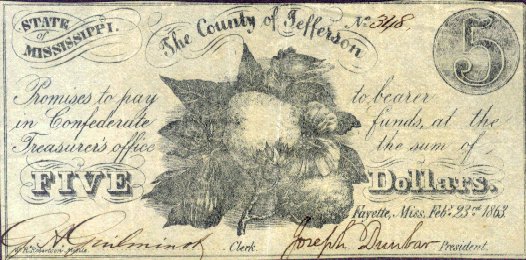
$5 ripe cotton boll (#9)
Signed by Guilminot
and Dunbar.
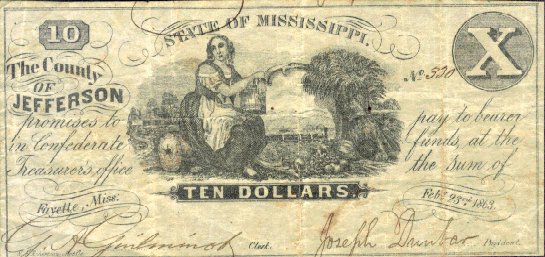
$10 Ceres goddess of harvest (#11)
Signed
by Guilminot and Dunbar.
There was no Third Series, as United States forces took over the county in late summer 1863. These six notes, with the three typeset notes mentioned but not shown, make the complete set of wartime Fayette money.
Reference: L. Chandler Leggett, Mississippi Obsolete Paper Money and Scrip (Iola, Wisc.: Krause Publications, 1975.)